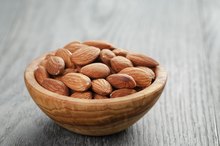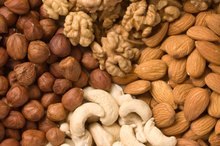What does fact checked mean?
At Healthfully, we strive to deliver objective content that is accurate and up-to-date. Our team periodically reviews articles in order to ensure content quality. The sources cited below consist of evidence from peer-reviewed journals, prominent medical organizations, academic associations, and government data.
- Medline Plus; "Magnesium in Diet"; Dr. Linda Vorvick; February 9, 2009
- Office of Dietary Supplements: Magnesium
The information contained on this site is for informational purposes only, and should not be used as a substitute for the advice of a professional health care provider. Please check with the appropriate physician regarding health questions and concerns. Although we strive to deliver accurate and up-to-date information, no guarantee to that effect is made.
How Much Magnesium Per Day?
Magnesium is an essential mineral necessary for proper functioning and maintenance of the body. It is vital that you get adequate amounts of magnesium daily to support health and prevent deficiency. Fortunately, magnesium is naturally abundant in a variety of foods such as grains, vegetables, legumes and nuts. Consult a registered dietitian for your specific vitamin and other nutritional requirements.
Magnesium Function
All bones, cells and organs in the body require magnesium for proper functioning and maintenance. The mineral is required for the contraction and relaxation of muscles and nerve function. It also necessary for the production of enzymes and other proteins in the body. Magnesium is an essential mineral because it cannot be made in your body and must be abundant in your diet. Magnesium deficiency is rare in the United States. Individuals most at risk for deficiency include those with gastrointestinal disorders, burn victims or patients just out of surgery. Common symptoms associated with deficiency include insomnia, rapid heartbeat, numbness and muscle weakness.
- All bones, cells and organs in the body require magnesium for proper functioning and maintenance.
- It also necessary for the production of enzymes and other proteins in the body.
Daily Recommendations
Magnesium Amino Acid Chelate and Anxiety
Learn More
According to the Institute of Medicine, men require 400 to 420 mg of magnesium daily while women require 310 to 320 mg. Pregnant or lactating women require slightly greater amounts, approximately 310 to 400 mg, per day. Children require 80 to 240 mg daily, while adolescents require 360 to 410 mg of magnesium. Individuals using certain medications or who have chronic absorption problems might require higher amounts of magnesium daily. Consult your health care provider or registered dietitian for specific requirements based on your activity level or condition.
- According to the Institute of Medicine, men require 400 to 420 mg of magnesium daily while women require 310 to 320 mg.
- Pregnant or lactating women require slightly greater amounts, approximately 310 to 400 mg, per day.
Food Sources
Green leafy vegetables are rich sources of magnesium. Some examples include Swiss chard, spinach, mustard greens and broccoli. A half cup of cooked spinach provides 75 mg of magnesium, or 20 percent of the Recommended Daily Value, or RDA. Significant sources of magnesium can also be found in various legumes, nuts and seeds, such as:
- flaxseed
- peas
- lentils
- beans
- cashews
- almonds
One ounce of dry-roasted cashews provides 75 mg of magnesium. Other sources of magnesium include fruits and whole grains. One medium-size banana provides 30 mg of magnesium.
- Green leafy vegetables are rich sources of magnesium.
- Significant sources of magnesium can also be found in various legumes, nuts and seeds, such as: * flaxseed
* peas
* lentils
* beans
* cashews
* almonds One ounce of dry-roasted cashews provides 75 mg of magnesium.
Diet Considerations
Potassium & Magnesium Dosage
Learn More
Do not rely solely on one food source for your daily magnesium intake. You can ensure adequate intake of magnesium by consuming a balanced diet that incorporates various legumes, vegetables, nuts, seeds and whole grains. Aim for at least five servings of fruits and vegetables daily and 8 to 10 servings of whole grains. Magnesium can also be taken as a dietary supplement 2. Ask your health care provider if you need to take a daily multivitamin formula with magnesium to help ensure intake.
- Do not rely solely on one food source for your daily magnesium intake.
- You can ensure adequate intake of magnesium by consuming a balanced diet that incorporates various legumes, vegetables, nuts, seeds and whole grains.
Related Articles
References
- Medline Plus; "Magnesium in Diet"; Dr. Linda Vorvick; February 9, 2009
- Office of Dietary Supplements: Magnesium
- Rosanoff, A., Weaver, C. M., & Rude, R. K. (2012). Suboptimal magnesium status in the United States: are the health consequences underestimated?. Nutrition Reviews, 70(3), 153-164.
- Dupont, C., Campagne, A., & Constant, F. (2014). Efficacy and safety of a magnesium sulfateârich natural mineral water for patients with functional constipation. Clinical Gastroenterology and Hepatology, 12(8), 1280-1287.
- D'Angelo, E. K., Singer, H. A., & Rembold, C. M. (1992). Magnesium relaxes arterial smooth muscle by decreasing intracellular Ca2+ without changing intracellular Mg2+. The Journal of Clinical Investigation, 89(6), 1988-1994.
- Sojka, J. E. (1995). Magnesium supplementation and osteoporosis. Nutrition Reviews, 53(3), 71-74.
Writer Bio
Anthony Isaac Palacios has been a professional writer for more than five years for various media including magazine, newspaper and the Internet. He has a Master of Science in dietetics and nutrition and specializes in health and nutrition articles for the general public. Palacios enjoys cooking with wine, and sometimes even adding it to the food.









